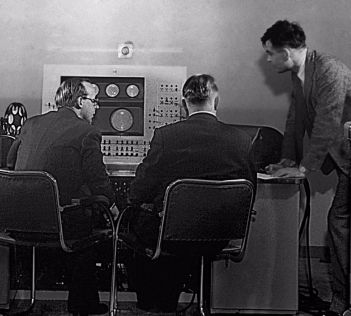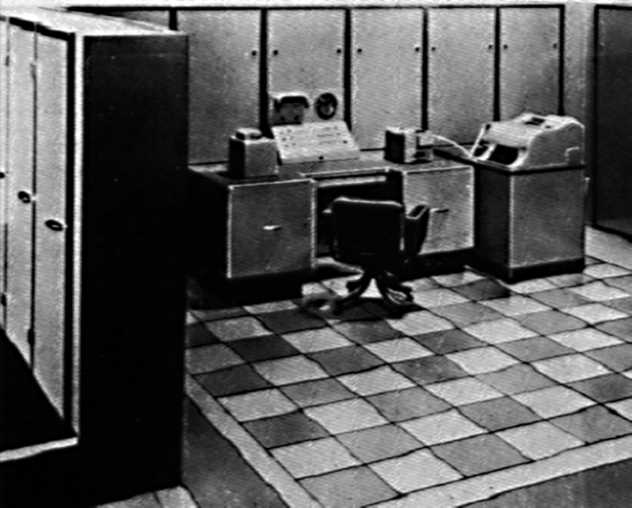| Manchester Computers of the 1950s |
| Written by Historian | |||
Page 1 of 2 In the period after WW II, Manchester in the UK was one of foremost centers of computing expertise. In 1948 Tom Kilburn and Freddie Williams designed, “Baby" or Small Scale Experimental Machine and followed up with the world's first stored program computer, the Manchester Mark I in 1949. Software for the Mark I was written by Alan Turing, who was appointed Deputy Director of the Computing Machine Laboratory in 1949.
Typically the early pioneers of computing hardware built one machine that their reputations rested upon. Sometimes the explanation was that they were building the machine as a tool to achieve something else. Once it was built they were happy to use it and return to their original interests. However, in a few cases the machines became their interests, if not their obsessions. In the case of Tom Kilburn and his colleagues at Manchester this passion for building new machines resulted in some of the innovations that we now regard as part of modern computing. The Manchester Mark I deserves consideration as the first stored program digital computer. However, the first computers were very different in design from what we recognize today as standard architecture. After Von Neumann saw the ENIAC he wrote a paper that outlined the idea of a stored program computer- where the CPU accesses both data and instructions from a single memory. This is why we refer to the basic stored program design as “Von Neumann” architecture. But this is just the start. The early machines struggled to implement any sort of memory and electronics was so expensive and unreliable that bit serial architecture was essential. That is, the early machines were 1-bit machines in something like the same sense that our current machines are 32-bit or better. With a design of this sort you would expect that more advanced ideas would be slow in coming but the fundamental hardware components developed so fast that it was possible not only to start thinking about sophisticated designs but to build them. Mark II with floating point hardwareSo it was at Manchester. After finishing the Mark I the minds of the design team turned to building a Mark II (or MEG, standing for MEGacycle) machine. In 1951 the proposed design was way ahead of current machines but it was nevertheless derived from the Mark I. It used the same 40-bit word and one-address instruction format. The ALU, Arithmetic Logic Unit, was still serial but it was fed from a random access memory via a 10-bit wide bus. It also abandoned the use of CRT storage in favor of magnetic core.
Alan Turing (right) at the console of the Mark II
What is really remarkable about the Mark II is that it incorporated hardware floating point arithmetic based on a 30-bit mantissa, 10-bit exponent and a base of 2^24. As always from our pampered and staid viewpoint it is difficult to understand how revolutionary this was. Programmers at the time actually argued that they didn’t want it! They claimed that being restricted to any numeric format was a bad idea. While the Mark II was being built, two IBM people visited the lab and were told by Kilburn that they were building a machine with floating point hardware. They phoned home at once and any hesitation that IBM were having about building the 709 scientific computer with hardware floating point was at an end - they just did it. The Mark II was still a valve machine but during the same period, 1952-1955, the Manchester team worked on an experimental transistor computer. Known then as “crystal triodes” the germanium point contact transistors were almost as unreliable as valves! The experimental transistor computer was slower than Mark II - not unreasonably since it lacked any high speed registers. All storage was provided by a fixed head magnetic drum! By 1955 junction transistors were available and these were consistent and reliable and so a commercial version of the machine, the MV950, was built by Metropolitan-Vickers. Enter FerrantiSurprisingly it was the Mark II that was converted into a commercial machine by Manchester’s main industrial collaborator, Ferranti. Another surprise is that Ferranti were never that keen on being in the computer business. When the Mark I was unveiled Ferranti were committed to producing a commercial version, with the help of some government money. In 1951 the NRDC (National Research and Development Council) agreed to order four machines based on cost price plus 7.5% profit. Despite this, and not having any UK competitors, Ferranti still found marketing tough. They had severe doubts. Even Douglas Hartree, one of the Manchester computer pioneers predating Kilburn and Williams, told them “We have a computer in Cambridge, there is one in Manchester and at the NPL. I suppose there ought to be one in Scotland, but that’s about all.” He really should have known better! In the end they sold about eight machines at around £90,000 each, a lot of money at the time. Because Ferranti was a multi-product company with a large turnover in electrical switchgear, meters and transformers, it had little reason to pin its future on newfangled, unreliable and expensive computers. It was also a family run company and Sir Vincent de Ferranti had a simple view of the situation. Lord Halsbury, boss of the NRDC, summed it up as “..if Sir Vincent were looking for a new enterprise to invest Ferranti money in, he would not pick computers. He has, however, no objection to a Government agency picking computers for him provided that he is fully compensated for the use of Ferranti facilities.” Hardly surprising that marketing wasn’t Ferranti’s strong point. Even so, Ferranti took on the MEG and renamed it the Ferranti Mercury - and it was fast, roughly twenty times faster than the Mark I. The floating point hardware included made it an ideal machine for scientific use - and this was its main market. It was fast, reliable, good value and it sold reasonably well. The Mercury
<ASIN:0333257502> <ASIN:0813342643> <ASIN:0316491977>
|
|||
| Last Updated ( Saturday, 09 October 2021 ) |


